Roger Wyand QC, Deputy High
Court Judge:
1.
This is a patent infringement action. As sometimes happens, it was
started as an action for a declaration of non-infringement of two patents of
which the Defendant is the proprietor and a declaration that the patents are
invalid. The Defendant counterclaimed for infringement. It was agreed by the
parties that it would be treated as a conventional patent infringement action
with a counterclaim for invalidity.
2.
The Defendant has consented to the revocation of one of the patents.
There is an application for a conditional amendment to the other patent. The
invalidity case is based on a prior publication by the Defendant by the supply
and/or sale of a product, the Freebit H1, which is said to be an anticipation,
and anticipation by and obviousness over a US patent application, US
2002/0096391, Smith. If the primary prior publication case is made out, it is
accepted that the Patent is invalid and the conditional amendment will not cure
the invalidity. There are also objections of added matter in the claims as
granted and lack of clarity and added matter in the proposed amended claims.
Subject Matter
3.
This action concerns European Patent 2177045 (“the Patent”). The title
of the Patent is “Improved Earpiece”. The earpiece of the Patent is an
‘in-ear’ as opposed to an ‘over the ear’ device, particularly suitable for use
with mobile devices such as mobile telephones or portable music players and the
like, although the Patent covers use for more specialist equipment such as
hearing aids. It is intended to provide an earpiece that is more comfortable
and more stable than prior art devices. There are 5 claims but claims 2 to 5
are dependent claims and no independent validity is claimed in respect of any
of them. The only relevant claim for validity is claim 1.
The Human Ear
4.
In order to understand the invention it is necessary to know the basic
anatomy of the outer ear. Below is a diagram of the outer ear with the
relevant parts identified:
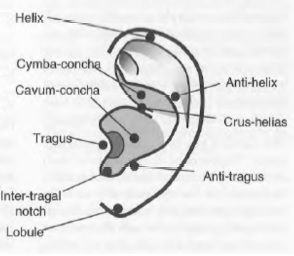
5.
The following parts are important for understanding the claims of the
Patent:
i)
The curved ridge around the outer edge of the top half, called the anti-helix;
ii)
The raised ridge of cartilage running outwards from the head, called the
crus-helias;
iii)
The hollow bowl shaped region called the concha (referred to in
the Patent as the ‘ear mussel’). It is divided into the cymba-concha
and the cavum-concha by the crus-helias;
iv)
The tragus and anti-tragus with the inter-tragal
notch between them; and
v)
The ear canal, shown on the diagram as a dark patch, which is
partially hidden by the tragus.
The Patent
6.
The priority date of the Patent is 1st June 2007. The Patent
is a commendably brief document, the specification occupying just over three
columns of description and another column of 5 claims. The first column headed
“Background Information” of just over one column refers to prior art earpieces
and their problems. These problems can be summarised as:
i)
The use of a bow for the earpiece and attached microphone, which is not
good for use with mobile devices;
ii)
The use of an ear plug in the ear canal which suffers from the
variability of the size of people’s ear canals making it difficult to mass
produce ear plugs to fit a range of people. They also tend to feel
uncomfortable and block ear wax in the ear canal;
iii)
Devices which are retained in the ear by applying outward forces to the
inner parts of the ear cavity cause discomfort.
7.
The objective of the invention is said to be: Based on the prior art
the object of the invention is to avoid these disadvantages and limitations and
simultaneously provide a further improvement in stability and comfortable
attachment of an ear unit with the possibility of further functionality.
8.
The summary of the invention is said to be: provided by a device as
disclosed by claim 1. Further features of the invention are disclosed by the
remaining dependent claims. The shape of the ear unit keeps the ear canal to
certain degree open towards the outer environment for improved comfort when
compared to a unit that closes or blocks the ear canal. This latter
feature does not appear in the claims
9.
Claim 1 as broken down into integers by the Claimants’ expert is as
follows:
(i)
Ear unit for stable fittings in an ear,
(ii)
wherein said ear unit (10) is shaped as a decremental curve,
(iii)
in that said decremental curve (9) of the outer part of the ear
unit (10) corresponds to antihelix (13) of the ear
(iv)
with a surface shaped in such a way that the curve falls along
the inner part of the antihelix (13)
(v)
and is partly positioned under antitragus (3),
(vi)
and that the distance between the ends (5, 8) of the decremental
curve is approximately equal to the distance between a first cavity formed
under the tragus (4) of the ear and second cavity covered by the lower node
(15) of the antihelix of the ear,
(vii)
the upper part of the curve projecting in underneath a flap (2)
covering the lower part of the second cavity,
characterized
in that
(viii)
said ear unit has a curvature providing an improved attachment in
that
(ix)
said curvature follows the inner surface of the ear mussel (22)
to provide a contact surface,
thereby enabling the ear unit to fit closely against the
ear mussel when the ear unit (10) is positioned into the ear.
10.
Fig. 1, set out below, shows schematically, an ear with a decremental
curve inserted (the dotted line). Fig. 5 shows an embodiment with the
decremental curve extending from 5 to 8.
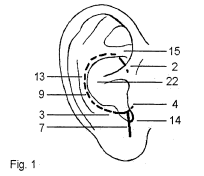
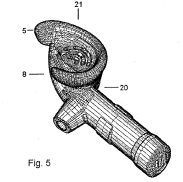
11.
The lower part, 7 on Fig. 1, is optional and is said to extend from
the curve while providing a guide and a weight for the correct positioning of
the ear unit by more or less lying in the intertragic notch of the ear.
12.
The Patent explains that although the outer part of the ear differs from
person to person these differences are not so great as with the ear canal, so
that only 2 or 3 different sizes will be necessary to cater for the
differences. It also states that investigations show that a contiguous line
in the form of a decremental curve will fit in to the ear of nearly everyone.
13.
The pre-characterising part of the claim is the subject of an earlier
patent by the same inventor and this design is referred to as Berg 1, being the
name of the inventor. The post-characterising part of the claim specifies a
second curve which is said to be formed in such a way that it follows along
the inner surface of ear mussel when the ear unit is positioned into the ear.
This contact surface provides further stability since a larger area is placed
against the ear mussel, and thereby increased comfort.
14.
This second curvature is shown at 21 in Fig. 5 above and can be seen
more clearly in Fig. 3 and Fig. 4 below:
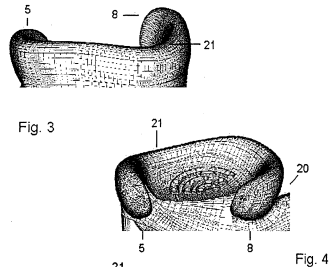
15.
This second curvature is designed to follow the floor surface of the
concha which is not flat. The concha is bowl shaped and is split into two
parts by the raised ridge of cartilage called the crus-helias. This ridge is
less prominent as it approaches the antihelix. In order to follow the concha
surface and thereby increase comfort, it is necessary to curve the ear unit not
only in the X-Y plane where the decremental curvature is, but also in the Y-Z
plane as shown in the diagrams below.
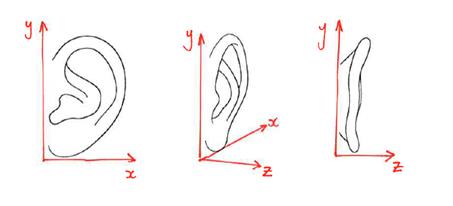
The Proposed Conditional Amendment
16.
Freebit proposes an amendment to claim 1 of the Patent in the event that
claim 1 is held to be obvious or anticipated by Smith. It is accepted by
Freebit that the amendment would not assist if claim 1 is held invalid by prior
publication of the Freebit H1 device.
17.
Bose say that, in any event, the proposed amendment is not allowable as
it lacks clarity and it adds matter.
18.
The proposed amendment is to add “further characterized in that the
ear unit (10) is arranged with an incision (20) which positions itself into the
intertragic notch (14) when the ear unit (10) is positioned in the ear.”
The Witnesses of Fact
19.
Freebit called two fact witnesses who were cross-examined in respect of
the alleged prior publication, Mr Vidar Sandanger and Mr Richard Steenfeldt
Berg. Mr Sandanger is the Chief Executive Officer of Freebit and Mr Berg is
the inventor of the Patent. Both witnesses are Norwegian. They both speak
English well and gave their evidence in English. They had a little difficulty
with the precise meaning of some English words but I do not believe this
affected their evidence adversely.
20.
Mr Sandanger was not able to give first hand evidence on many of the
issues as he was not connected with the Defendant until he became CEO in
January 2007. However, there were several witnesses who could have given
information about what happened in Metafax (the previous name of Freebit) and
were involved in the design of the Freebit H1.
21.
From Metafax there were multiple potential witnesses who could have
given first hand evidence about the events in question for example Mr Asle
Berger, who attended every board meeting the minutes of which formed the
entirety of Freebit’s actual documentary evidence, Mr Gregussen, Mr Sandanger’s
predecessor during 2006, Mr Hviding, who attended the relevant board meetings
and was there in 2006, amongst others. As for the designs, Vidar Pederson
actually produced the CAD drawings for all of the H1 Products. These witnesses
are not only alive and well and apparently communicating with Mr Sandanger
about the case, but they have an active interest in the litigation - they are
shareholders in Freebit whose future is said to depend on the case. So their
absence cannot be explained by unavailability. The only explanation can be that
they were not called because their evidence would have been unhelpful to
Freebit in one or more ways, either as to the characteristics of the Freebit H1
(in whatever version) or the commercial position. Mr Sandanger was unable to
offer any rational explanation for their absence.
22.
It was not just that they were not called when they could have been. Mr
Sandanger sat down with the various candidates and they decided that he would
give evidence because “I can do it better than them”. This was not a
reference to Mr Sandanger knowing the events better - he wasn’t even
there for much of the material period. Mr Sandanger said it was because “I
have the oversight… I have the oversight of what has been going on”. In
other words, although Mr Sandanger was the least well placed in terms of
setting out the facts as they occurred in 2006 before he arrived, he was the
best placed to know what needed to be said in the context of the litigation.
23.
It is open to the Court to draw adverse inferences from the silence or
absence of a witness who might be expected to have material evidence to give on
an issue in an action (see the principles set out in Wisniewski v Central
Manchester Health Authority [1998] PIQR 324 at 340 pre Brooke LJ). In this
case I do draw an adverse inference from the absence of these potential
witnesses.
24.
When, as here, there is an allegation of prior publication by the
patentee, it is particularly important that the patentee puts the best evidence
before the Court. It is not enough for the patentee to sit back and say the
onus is on the party alleging prior publication. The patentee is the party
with the best access to the facts and it is incumbent on them to establish
those facts either by documents or witness evidence or both once a case to
answer has been raised.
25.
Mr Berg was attempting to give evidence as to events that happened over
ten years previously so, understandably, his evidence was at times
contradictory and changed during the course of his cross-examination.
Nevertheless, some aspects of his evidence were unsatisfactory. In his second
witness statement he said:
“I have been asked to clarify briefly my involvement in this
case for Freebit. I was first contacted by Mr Sandanger about this case in
September 2017, when I was told by Mr Sandanger about a case involving Bose and
Freebit was taking place in the UK. Mr Sandanger told me that I might be asked
to help at some stage. I was not contacted again to help with the case until
mid-January 2018 when Mr Sandanger put me in touch with Freebit’s solicitors,
Innovate Legal, with a view to me giving written evidence.”
26.
In cross-examination it emerged that Mr Berg had been approached by Mr
Asle Berger in September 2017. He had about six meetings with Mr Berger about
this case. Although he could not recall exactly what they had talked about, he
did recall that he had been asked by Mr Berger what he could remember about things
back in 2006. He was hired as a consultant in about October 2017 and at that
time there was no talk of him being a witness. At the last meeting, in January
2018 there was talk about him being a witness and they stopped considering him
as a “helping consultant for research”.
27.
This changing story cannot be put down to the passage of time. I found
Mr Berg an unsatisfactory witness. I am unable to rely on some aspects of his
evidence unless it is corroborated by documents of which there are few.
The Experts
28.
Bose’s expert is Graham Frost. Mr Frost has a bachelor’s degree in
electronic engineering and a master’s degree in acoustic and vibration
technology. For 23 years (starting in 1988), Mr Frost worked at PC Werth,
where he was Technical Director. PC Werth is a supplier of audiology products,
such as hearing aids, to hearing healthcare professionals. Since he left PC
Werth in 2010, Mr Frost has been a technical consultant and participates on a
number of British Standard Committees, including for hearing aids and
audiometric equipment and procedures.
29.
Freebit’s expert is Dr Wayne Staab. Dr Staab has a master’s degree in
audiology and a doctoral degree in hearing science. Starting in 1972 he worked
for 16 years in hearing aid manufacturing (at Telex Communications, Audiotone
and Dahlberg/Miracle Ear). Since 1988, he has been a private consultant. Dr
Staab has managed and supervised university and hospital hearing clinical
programs, both diagnostic and hearing aid-related and he has taught audiology-focused
courses at the University of North Dakota, Michigan State University, the
University of Wisconsin-Eau Claire, Arizona State University and Arizona School
of Health Science. Dr Staab has acted as an expert for Freebit in similar
proceedings in the US.
30.
No criticisms of substance were made against either expert. I found
their evidence straightforward and helpful.
The Skilled Person
31.
There is a disagreement between the parties as to the identity of the
skilled person. Freebit submit that the skilled person is someone in the field
of consumer electronics and not in the more specialist fields of custom made
hearing aids or audiology. Bose, on the other hand say that the skilled person
would be more generally someone who designed earpieces for general use so would
include an audiologist or would consult an audiologist.
32.
Both of the experts are audiologists although neither of them were
involved in the field of consumer electronics before the priority date of the
patent. There is nothing inventive in involving an audiologist in the design
of an earpiece for consumer electronics but I do not think that it makes any
difference in this case. I believe that the Patent is directed to the person
in the consumer electronics field who would, if necessary, consult an
audiologist.
The Common General Knowledge
33.
The skilled person would have knowledge of existing earpieces in the
consumer electronics field. He or she (I shall refer to the skilled person as
“he” for brevity) would also know generally of custom made hearing aids. He
would also have a working knowledge of the outer ear, including the variations
in the size and shape of the ear canal in particular.
34.
The skilled person would also know of the requirements for comfort and
stability of earpieces, particularly those that would be worn for extended
periods of time.
The Law of Construction
35.
The approach of this court to the construction of patent claims is now
well-established. For present purposes, it is sufficient to refer to the
following summary provided by Jacob LJ in Virgin Atlantic Airways Ltd v
Premium Aircraft Interiors Group [2009] EWCA Civ 1062; [2010] RPC 8, in
the main interpreting the judgment of Lord Hoffmann in Kirin-Amgen v
Transkaryotic Therapies (No.2) [2005] 1 All ER 667:
“(i) The
first overarching principle is that contained in article 69 of the European
Patent Convention.
(ii) Article
69 says that the extent of protection is determined by the claims. It goes on
to say that the description and drawings shall be used to interpret the claims.
In short the claims are to be construed in context.
(iii) It
follows that the claims are to be construed purposively—the inventor's purpose
being ascertained from the description and drawings.
(iv) It
further follows that the claims must not be construed as if they stood
alone—the drawings and description only being used to resolve any ambiguity.
Purpose is vital to the construction of claims.
(v) When
ascertaining the inventor's purpose, it must be remembered that he may
have several purposes depending on the level of generality of his invention.
Typically, for instance, an inventor may have one, generally more than one,
specific embodiment as well as a generalised concept. But there is no
presumption that the patentee necessarily intended the widest possible meaning
consistent with his purpose be given to the words that he used: purpose and
meaning are different.
(vi) Thus
purpose is not the be-all and end-all. One is still at the end of the day
concerned with the meaning of the language used. Hence the other extreme of the
Protocol—a mere guideline—is also ruled out by article 69 itself. It is the
terms of the claims which delineate the patentee's territory.
(vii) It
follows that if the patentee has included what is obviously a deliberate
limitation in his claims, it must have a meaning. One cannot disregard
obviously intentional elements.
(viii) It
also follows that where a patentee has used a word or phrase which,
acontextually, might have a particular meaning (narrow or wide) it does not
necessarily have that meaning in context.
(ix) It
further follows that there is no general ‘doctrine of equivalents’.
(x) On the
other hand purposive construction can lead to the conclusion that a technically
trivial or minor difference between an element of a claim and the corresponding
element of the alleged infringement none the less falls within the meaning of
the element when read purposively. This is not because there is a doctrine of
equivalents: it is because that is the fair way to read the claim in context.
(xi) Finally
purposive construction leads one to eschew the kind of meticulous verbal
analysis which lawyers are too often tempted by their training to indulge.”
36.
I shall adopt these principles in construing the Patent.
Issues of Construction
37.
The first issue of construction is of general significance, not
depending on the meaning of a particular term, and that is, whether the shape
of the earpiece is to be judged before insertion into the ear or when it is in
situ. Essentially the question is whether the claim covers a resilient ear
unit which can adapt to the shape of the ear or whether it is to be made to the
required shape before insertion into the ear. The relevant words of the claim
are: “ear unit for stable fittings in an ear, wherein said ear unit is
shaped… with a surface shaped in such a way that the curve falls along the
inner part of the antihelix and is partly positioned under antitragus … the
upper part of the curve projecting in underneath a flap … said ear unit has a curvature
…said curvature follows the inner surface of the ear mussel to provide a
contact surface thereby enabling the ear unit to fit closely against the ear
mussel when the ear unit is positioned into the ear.”
38.
Freebit submits that the requirements of the claim are satisfied by a
product which adopts the required curvature when placed within the ear.
Freebit says that a resilient ear unit which provided for the curvature and
associated contact surface by its flexibility and resilience achieves the
benefit of the invention for the reasons set out in the patent and so it is
inherently unlikely that such a limited construction was objectively intended.
39.
I cannot accept this. There is no suggestion in the Patent that the
‘shaping’ can be done by the ear itself. The shaping is required in order for
the ear piece to be able to fit into the ear. The concept of pushing something
into the ear for it to take a shape complementary to the space in the ear is
totally different to the disclosure of a shape which enables the unit to fit
closely to the ear mussel. It is the shape that is important in the Patent and
not the material from which it is to be made. The shape of the curve enables
the ear unit to fit closely against the ear. The ear unit must have that shape
before it is inserted into the ear.
40.
One of the aims of the Patent is to improve over the prior art which
involved the ear unit pressing against the ear causing discomfort. That
teaches against using an ear unit of flexible material that is not shaped appropriately
but adopts the shape by being compressed into shape by the ear when it is
inserted.
41.
The first specific term requiring to be construed is “decremental” in
the feature:“shaped as a decremental curve, in that said decremental curve
of the outer part of the ear unit corresponds to antihelix of the ear with a
surface shaped in such a way that the curve falls along the inner part of the
antihelix”.
42.
Both experts agree that decremental is not a term of art. In the
context of the specification and particularly Fig. 1 of the Patent, I do not
think that this is intended to be a very precise term but rather is intended to
indicate a curve that generally follows the form of the antihelix in having a
decreasing radius along the curve. It is not intended to indicate a regular
decrease but rather to be a reasonable fit to an average human antihelix. On
the other hand, I believe that the curve must be continuous and cannot have
gaps in it. It must be shaped to fall along the inner part of the antihelix
and does not do so if it only touches the inner part of the antihelix at
various points on the antihelix.
43.
The second term requiring to be construed is the description of the
second curve in the post-characterising part of the claim: “said curvature
follows the inner surface of the ear mussel to provide a contact surface
thereby enabling the ear unit to fit closely against the ear mussel when the
ear unit is positioned into the ear”.
44.
Bose argues that the purpose of this feature is to keep the earpiece in
place thereby enabling the hearing element to be kept somewhat away from the
ear canal. However, this feature is not part of the claim. The purpose of
this curvature is clear from [0021] of the Patent which states: “This
contact surface provides further stability since a larger area is placed
against the ear mussel, and thereby increased comfort”.
45.
In the context of the specification and the figures, particularly Figs.
3 to 5, it is clear that this second curvature is along the edge of the
earpiece that sits in the concha and rests against the bottom of the concha
bowl preventing the earpiece from being lifted off the bottom by the crus
helias.
46.
The third term to be construed appears in the proposed conditional
amendment: “said ear unit is arranged with an incision.”
47.
Bose say that an incision means something that is ‘cut in’ to the
device, referring not only to the shape but also to how the shape was created.
In the context of the specification and the drawings I do not think that the
skilled person would think that this was what the patentee had intended. In
the context I believe that this should be taken to indicate a shape in the
nature of an incision rather than a shape having been produced by cutting. It
is clear how the ‘incision’ is intended to co-operate with the intertragic
notch and the meaning is clear.
The Alleged Prior Publication
48.
Metafax, as Freebit was then called, arranged for the manufacture of a
product, designed by Mr Berg, in South Korea in 2005. A Mr Pedersen was
engaged to work with Mr Berg to digitalise Mr Berg’s design to supply to
Keumbee, the Korean company selected by Metafax to be the manufacturer of the
ear units. The ear unit was called the Freebit H1.
49.
In cross-examination, Mr Berg drew the profile of this device and said
that it did not have the second curve in the post-characterising part of the
claim (“the second curve”) but that it did have a slight ‘waning’ at the top of
the decremental curve in the Z-axis. Bose submit that this waning did
constitute the second curve. Mr Berg described it as having a substantially
planar C-shape. This product was the H1 Type A. There is no challenge to the
fact that this was made available to the public and Freebit accepts that it had
all the pre-characterising features of the claim but Freebit denies that it had
the post-characterising second curve.
50.
Freebit say that there were three models of the H1, Type A, Type B and
Type C. On the 24th November 2017, in response to a Request for
Further Information, Freebit stated: The internal electronics may have
undergone revision, but the Defendant believes that there was only a single
shape of the H1 Product. The Statement of Truth on this response was signed
by Mr Sandanger. This response was subsequently amended on the first day of
the trial to read: There were three types of the H1 Product, namely types A,
B and C. To the best of the Defendant’s recollection, the design of the shape
of types A and B was the same, the only difference between them being the
internal electronics. Types A and B had an ear interface made in accordance
with Berg. The design of the shape of type C was different to both type A and
type B. Type C was made in accordance with the claims of the Patents.
51.
There is a substantial issue of fact concerning the history of the
various types, their shapes and the dates on which they were available in
Norway.
The Chronology
52.
The only contemporaneous documents are the Metafax Board Minutes which
are in Norwegian. They have been translated into English by machine. Some
were corrected by Mr Sandanger during cross-examination. There are no
drawings, samples or products although Mr Berg said that he had had a number of
type C products in his possession but that he had lost the last of these
shortly before he was asked by Freebit whether he had one. This was,
apparently, some time after he had been engaged as a consultant to help Freebit
prepare this case. During the course of the trial some documents showing
transactions with an air-freight company in the relevant period were obtained,
having not apparently been requested earlier. They show some transactions in
the relevant period.
53.
A short summary of the most relevant dates is as follows:
|
Date
|
Event
|
|
1/11/2000
|
Filing date for priority document
for the Berg 1 patent with the C-curve
|
|
2003
|
Mr Berg sells Freebit project
to Metafax
|
|
2005
|
Metafax decides to go ahead with
project, Pedersen engaged to digitalise Berg’s design
|
|
12/2005
|
Pedersen sends CAD drawings to
Keumbee and Berg visits Keumbee in South Korea
|
|
13/03/2006
|
Board Minutes – website for Freebit
will be prepared in co-operation with Asono
|
|
May/June 2006
|
Preparation of user guide started.
Berg asks Keumbee to reduce height of C-curve at mid-point. Berg not happy
with result and not incorporated into product
|
|
17/08/2006
|
Board Minutes – 200 pieces to be
delivered 30/09, 3000 on 4/10 and 2000 on 11/10 2006
|
|
12/2006
|
Berg instructs Pedersen to produce
CAD drawings incorporating the second curve
|
|
8/12/2006
|
Board Minutes – plan is that 1000
type A Freebits will arrive for Christmas and 1000 new improved type B will
arrive in the New Year
|
|
18/12/2006
|
First recorded shipment into
Metafax warehouse at Oslo airport. Earliest cached web page on Wayback
Machine offering H1 for sale.
|
|
01/2007
|
Sandanger joins Metafax as CEO.
New product with second curve shown to Sandanger who is enthusiastic.
Keumbee told to halt production of H1 to replace with new product.
|
|
02/2007
|
Decision to file for patent on
second curve. Type B batch returned
|
|
7/02/2007
|
Record of third shipment to Metafax
warehouse
|
|
12/02/2007
|
First sale of H1 unit by Power
|
|
15/02/2007
|
Board Minutes – errors in type B.
Invites plan for development of next Freebit product.
|
|
16/02/2007
|
Article about Freebit H1 published.
Said likely to be type A or B
|
|
End Feb or beginning Mar 2007
|
Berg says only batch of type B
arrived and most shipped back
|
|
19/04/2007
|
Board Minutes – type B for repair
to new type C, delivery expected approx. 20/05
|
|
05/2007
|
Metafax instruct patent attorneys
to file application for the Patent.
|
|
16/05/2007
|
Board Minutes – return of type C
after repair expected next week.
|
|
1/06/2007
|
Priority date of Patent.
|
|
7/06/2007
|
Records show shipment to Metafax
warehouse.
|
54.
There are conflicting accounts of the dates, particularly as regards the
deliveries of the type C products. The Board Minutes are the only truly
contemporaneous records. The records of shipments arriving at Oslo have been
supplied by Airsped, the handling agent used, and come from contemporaneous
records but don’t actually state what was delivered or how many. The rest of
the dates are from the Freebit witnesses, Mr Berg and Mr Sandanger, trying to
recall when events happened from looking at the Board Minutes. The Freebit
witnesses say that the products were stored in the Metafax warehouse at the
airport for about a week before Metafax had access to them.
55.
Freebit say that the types A and B were both the design without the
second curve: type B just had different electronics. The type B were found not
to work properly, they could not connect to Sony mobiles and were sent back
almost as soon as they arrived. The type B were converted to type C when the
electronics were fixed and were then sent back to Norway. They didn’t arrive
in Norway until shortly before the priority date at the earliest, but most
likely, shortly after. They were not released to the market until after the
priority date.
56.
Bose point to the unsatisfactory nature of the evidence from Mr
Sandanger and Mr Berg, the absence of any documents that show the shape of the
products, the absence of any references as to why the products were being
changed other than the technical connection problem with type B and the absence
of any reference in marketing to the new ‘improved’ shape. They say that on
the balance of probabilities all of the three versions of the product had the
second curve. Mr Berg described the type A/B as having the decremental curve
being substantially planar and drew a diagram showing that it tapered slightly
at one end. Bose also point out that the review of the product (said to be
type A or B), published in a magazine in February 2007, contained the heading
“fits like a glove” and Mr Berg claimed that the Norwegian gymnastics team
could not dislodge products of the first design. All of this suggests that the
second curve was there in at least the type B, if not the type A.
57.
During cross-examination the picture below was put to Mr Berg. It was a
picture produced in evidence that he had put before the US Patent and Trademark
Office in proceedings there and it was said to show how the first Berg patent
worked. It shows the decremental curve and shade B is said to be the contact
area in the concha.
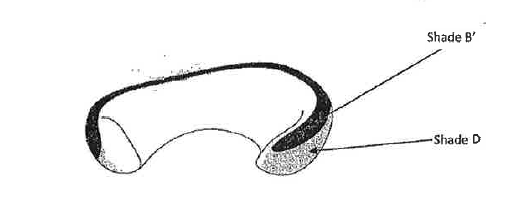
58.
It was put to Mr Berg that this showed a curve in the Z axis.:
“And there is curvature in the Z direction?
9 A. Yes, ever so slightly, I would add in.
10 Q. It is true, is it not, that every Freebit that has ever been
11 produced had some Z axis contouring to make it fit better
12 against the concha?
13 A. Not per se with that main objective. The main objective to
14 have this slight waning, as I would call it, still looking at
15 this picture, is to hit the antihelix better according to
16 where we want to have position at the bottom of the same total
17 overall structure. The very contact surface around the middle
18 section of the flow of the C structure is not that important,
19 for the main reason that the material needed on the outside of
20 the tragus notch to keep it out of the ear canal also keeps it
21 away from the lower part of the bottom of the concha.
22 Q. Right, but leave aside the purpose of it, the answer to my
23 question is correct, is it not, that it is right that every
24 Freebit produced had some Z axis contouring to make it fit
25 against the concha?
BERG - ALEXANDER
A. Yes, to make a fit. That to me, my Lord, is a
purpose phrase.
3 That is not what it is all about.”
59.
There is a further relevant piece of evidence which is the Asono website
which was published in 2006. Images were obtained from the Wayback Machine
which are high definition pictures of a Freebit ear unit and can be compared
with Fig. 5 and part of Fig. 2 of the Patent:“
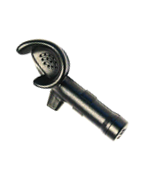
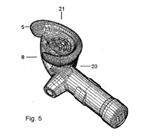
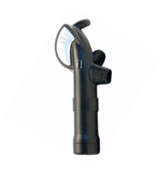

60.
The contemporaneous User Guide had a low quality picture which also
shows curvature in the Z direction. This was said by Freebit to be a picture
of a type C product. Mr Sandanger said that the User Guide photographs had
been changed from the type B to the type C but the manual was an Asono manual
and there would have been no reason to change the photograph as it was only
showing how to put the product in the charging cradle.
61.
The Asono website also showed a video of a rotating Freebit product.
Bose’s solicitors extracted a still from this video showing the product side
on. This shows a clear curvature in the Z direction:

62.
When this was put in evidence by Bose the initial response was that this
must be a product of distortion but no evidence of this being likely or even
possible was put in.
63.
Mr Sandanger suggested that it might have been from CAD drawings and Mr
Berg speculated that Asono might have got the drawings of the rejected design
produced by Keumbee. Again, no evidence was put in to establish this
possibility.
64.
On the balance of probabilities I find that all of this establishes that
there was a second curve as required in the post-characterising part of the
claim present in the type A and/or type B ear units and there was a prior
publication by the supply of these units before the priority date of the
Patent. I am unable to determine whether the type C ear units were made
available in Norway prior to the priority date due to the paucity of
contemporary documents but the issue is irrelevant in the light of my finding
in respect of the type A and/or B units.
Smith Anticipation
65.
The Smith US Patent Application is titled “Flexible Ear Insert and Audio
Communication Link” and is described in the specification as:
“This invention relates to a flexible ear insert that is
adapted to be comfortably and inconspicuously worn in the ear of a user so as
to be reliably retained therein when the user is running or experiencing sharp
head turns. The flexible ear insert has particular application as a
communication link by which to supply clear audio messages from a remote
transmitter (e.g. a radio) directly to the ear canal of the wearer.”
66.
The shape of the earpiece can be seen from Figs. 2, 3 and 4 and its
in-ear position from Fig. 8 (Figs. 2, 3 and 4 show an earpiece intended for a
left ear whereas Fig. 8 shows an earpiece in a right ear):
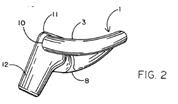
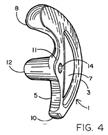
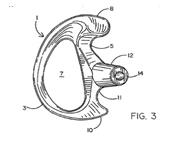
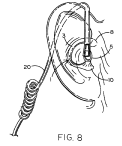
67.
Smith describes how the device sits in the ear:
“[0025] In the
installed condition of FIG. 8, the arcuate
band 3 of ear insert 1 is received around the
conchaebowl of
the ear to thereby prevent the insert from falling out
of the
ear. Because of its flexible nature, the arcuate band
3 is
adapted to be compressed and reshaped within the
central
open air space 7 so as to conform to the shape of the
wearer's
ear. The cushion 8 formed at the top of ear insert 1
will be
received against a ridge at the top of the ear,
sometimes
known as the helix. The tab 10 which protrudes from
the
bottom of the insert 1 is positioned to fit within a
small notch
that lies below the bowl of the ear.
[0026] With the ear insert 1 held snugly in place, the
pad
11 at the mid-point of the bridge 5 through which
sound
channel 14 is formed fits behind the targus of the
ear,
whereby the canal tube 12 to which the acoustic tubing
20
is connected, will extend into the bowl of the ear to
be
positioned directly above and in axial alignment with
the ear
canal in order to advantageously provide loud and
clear
audio signals from the audio receiver directly to the
ear of
the wearer. What is more, the open air space 7 surrounded
by the band 3 and bridge 5 at the center of ear insert
1 will
be automatically positioned above and aligned with the
bowl
of the ear to establish a sound passage between the
wearer's
environment and his ear canal. Therefore, at the same
time
that the wearer receives communications transmitted
from a
remote source to the ear insert 1, he will also be able to hear
nearby sounds that are transmitted from his surroundings
to
his ear canal via the air space 7, as well as the open area
between the protrusion 10 and pad 11 along bridge 5. Such
sounds may include gun shots, shouts for help, spoken
words, etc.”
68.
It is accepted by Freebit that Smith has all the features of claim 1
except the second curvature. It is denied by Freebit that Smith has the
incision required by the proposed amended claim 1.
69.
Freebit relies on five aspects of the disclosure of Smith that indicated
that his device would not have or adopt a curve corresponding to the typical
undulation in the floor of the concha such that it achieves substantial contact
with it. These are:
i)
The compressed nature of the device;
ii)
The air space over the concha;
iii)
The bowed profile of the device in plan view;
iv)
The position of tab 10.
70.
Mr Frost was cross-examined on these points and how they were consistent
with one of the objectives of Smith which Freebit say is to lift the hearing
tube away from the concha bowl. However, the objective is to lift the device
away from the ear canal rather than from the concha bowl itself. To achieve
that objective, the device must touch the concha bowl in order to support the
device clear of the ear canal. It is correct that the device is so shaped that
it bows upwards in the middle of the decremental curve, between 1 and 3 on Fig.
3, but it can only do that if it is pushing against the concha bowl at the top
and bottom of the device. The device will then have a curve in the Y-Z plane.
The issue then is whether this curvature “follows the inner surface of the
ear mussel to provide a contact surface thereby enabling the ear unit to fit
closely against the ear mussel when the ear unit is positioned into the ear”
as required by the claim.
71.
I have construed this to require the contact to be with the ‘floor’ of
the concha bowl.
72.
Bose’s expert, Mr Frost, in his report referred to the fact that Smith
states that the device may be made of a flexible material and that it is
apparent that the design and flexibility of the device is intended to ensure
that the contact surface of the insert will follow the shape of the
concha/antihelix in use. Freebit’s expert, Dr Staab, did not agree with this
evidence when it was put to him in cross-examination. He referred to the Shore
hardness of the material referred to in Smith and said that it wouldn’t always
flex into an empty area suggesting that when the device is compressed there was
a very good chance that it will pop out of the ear at the antihelix area. Dr
Staab suggested that a softer material would be worse. He said that Smith was
talking about compressing into a centre space. He appears to be talking about
compressing the device so that it will fit into the concha which is what Smith
is clearly talking about but, of course, when the device is compressed,
inserted into the concha and then released, it will expand against the concha.
73.
Dr Staab accepted that the cushion, identified at 8 in the drawings,
provided a better fit because it has a profile that matches the profile of the
ear at that point and that if you wanted to improve Smith at the relevant date
it would be perfectly natural to improve the fit at the other end as well, if
it was not already in contact with the concha.
74.
Freebit argue that this would not mean that the device was in contact
with the concha along the rest of the device between 10 and 8. The teaching in
Smith is to use a flexible material so as to “tailor the insert to the
particular ear of the wearer in order to improve the fit and maximise comfort”.
I accept Mr Frost’s evidence that this means that the contact surface of the
insert will follow the shape of the concha/antihelix in use.
75.
Thus, although not all implementations of Smith will result in a device
that contacts the floor of the concha bowl along the length of its C-curve, it
teaches the use of a flexible material that will do so. Therefore, Smith
anticipates claim 1 of the Patent if contrary to my finding above, the Patent
covers the use of a flexible material that flexes to conform to the shape of
the concha bowl. Smith does not anticipate the claim as proposed to be amended
as it does not have the incision required by the amendment.
Obviousness over Smith
76.
This is a case in which the Pozzoli analysis is appropriate:
(1) (a)
Identify the notional “person skilled in the art”
(1) (b) Identify the relevant
common general knowledge of that person;
(2) Identify the inventive concept
of the claim in question or if that cannot readily be done, construe it;
(3) Identify what, if any,
differences exist between the matter cited as forming part of the “state of the
art” and the inventive concept of the claim or the claim as construed;
(4) Viewed without any knowledge of
the alleged invention as claimed, do those differences constitute steps which
would have been obvious to the person skilled in the art or do they require any
degree of invention?
77.
I have identified the skilled person and the common general knowledge.
I have also construed claim 1 and the proposed amended claim 1.
78.
Leaving aside the issue of whether the shape is preformed or is produced
by the pressure of the ear, and on the assumption that I am wrong and Smith
does not anticipate the Patent because it does not teach the second curve, the
presence of that curve is the difference between claim 1 of the Patent as it stands
and Smith.
79.
On the basis of Mr Frost’s evidence referred to above, it would be an
obvious step to improve Smith by using a flexible material that contacted the
floor of the concha at the base of the side wall of the concha.
80.
The difference between the proposed amended claim 1 and Smith is the
second curve combined with the ‘incision which positions itself into the
intertragic notch when the ear unit is positioned in the ear”.
81.
The evidence of Mr Frost was that circular earbuds with a stalk
extending downwards along the intertragic notch were commonly used in earphones
in the early 2000s and that they would have a groove which straddled the lower
part of the intertragic notch. He said that the use of such a space or
incision to co-operate with the intertragic notch was a well established and
very well known method of positioning devices within the ear at the priority
date of the Patent. Dr Staab agreed with this if the device had a part going
down from the body of the device sitting in the concha but Smith did not. He
pointed out that if one just swivelled the connection between the device and
the tube in Smith so that the tube went down instead of up and over the ear, no
incision would be needed as the tube connector extends outwards at first and if
it were rotated to take the tube down it would clear the intertragic notch
without need for an incision.
82.
Freebit also submits that modifying the Smith device would involve
modifying it for a different purpose to that for which Smith intended his
device, namely for use by security personnel. However, the skilled person is
in the field of in-ear headphones for personal electronic devices. Such a
person would not be wanting something for use by security personnel but would
be wanting something for use with personal electronic devices. I accept Mr
Frost’s evidence that adapting Smith to have a downward pointing part with a
gap to fit the intertragic notch would be a natural thing for the skilled
person to do. If that is an incision then it is obvious.
83.
The proposed amended claim is obvious over Smith.
Added Matter – The Law
84.
The general principles articulated by Aldous J in Bonzel v
Intervention (No 3) [1991] RPC 553 at 574 have been approved on numerous
occasions:
(1) To ascertain through the eyes of the skilled addressee
what is disclosed, both explicitly and implicitly in the application.
(2) To do the same in respect of the patent as granted.
(3) To compare the two disclosures and decide whether any
subject matter relevant to the invention has been added whether by deletion or
addition. The comparison is strict in the sense that subject matter will be
added unless such matter is clearly and unambiguously disclosed in the
application either explicitly or implicitly.
85.
The reason for
the rule was explained by the Enlarged Board of Appeal of the EPO in G1/93
ADVANCED SEMICONDUCTOR PRODUCTS/Limiting feature [1995] EPOR 97 at [Reasons
9]:
“With regard
to Article 123(2) EPC, the underlying idea is clearly that an applicant shall
not be allowed to improve his position by adding subject-matter not disclosed
in the application as filed, which would give him an unwarranted advantage and
could be damaging to the legal security of third parties relying upon the
content of the original application.”
86.
It has been
often stated the legal security of third parties would be affected if this were
not the rule because the applicant or patentee could gain an unwarranted
advantage in two ways if subject-matter could be added: first, he could
circumvent the “first-to-file” rule, namely that the first person to apply to
patent an invention is entitled to the resulting patent; and secondly, he could
gain a different monopoly to that which the originally filed subject-matter
justified (see e.g in Vector Corporation v Glatt Air Techniques Inc
[2007] EWCA Civ 805). See also Liversidge v Owen Mumford Ltd & Anor
[2012] EWPCC 33 on the importance of being able to ignore applications which do
not appear to have relevance because the skilled person is not doing anything
which would require the particular feature as described in the application as
filed to be included.
87.
One further
point has been emphasised inter alia by Kitchin J in European Central Bank v
Document Security Systems [2007] EWHC 600 (Pat), namely the importance of avoiding
hindsight. As he said, “Care must be taken to consider the disclosure of the
application through the eyes of a skilled person who has not seen the amended
specification and consequently does not know what he is looking for”.
88.
A particular,
and sometimes subtle, form of added matter is “intermediate generalisation”.
Pumfrey J described this in Palmaz's European Patents [1999] RPC 47, 71 as follows:
“If the
specification discloses distinct sub-classes of the overall inventive concept,
then it should be possible to amend down to one or other of those sub-classes,
whether or not they are presented as inventively distinct in the specification
before amendment. The difficulty comes when it is sought to take features which
are only disclosed in a particular context and which are not disclosed as
having any inventive significance and introduce them into the claim deprived of
that context. This is a process sometimes called 'intermediate generalisation.”
Added Matter – The Facts
89.
Bose raises two added matter objections. The first is to the claim as
granted and the second is to the proposed amended claim.
90.
The wording in the priority document of the part of the claim that is
now the post-characterising part of the claim was: “having a curvature
providing an improved attachment in that said curvature follows the bottom of
the ear mussel”. In the claim as granted this reads: “has a curvature
providing an improved attachment in that said curvature follows the inner
surface of the ear mussel to provide a contact surface, thereby enabling the
ear unit to fit closely against the ear mussel when the ear unit is positioned
into the ear”.
91.
Bose say that this is an intermediate generalisation. They say that the
only disclosure of this feature is at page 3 lines 31-32 of the priority
document and this is in the context of a specific embodiment which has a
hearing element retracted slightly relative to the curve such that there is the
formation of an opening between the auditory canal and its surroundings. Bose
submit that, if the claim is construed to embrace a device in which some of the
curve that follows the ear concha may be formed by part of the unit that
comprises the hearing element, then there is an intermediate generalisation.
The disclosure of that curve has been stripped of its intrinsic functional and
structural context, i.e. that the curve forms an opening between the auditory
canal and its surroundings.
92.
The Patent is subject to Opposition proceedings in the European Patent
Office and a hearing before the Technical Board of Appeal is imminent. I have
seen the Preliminary Opinion prepared for this hearing. It deals with this
objection in paragraphs 16.4 to 16.6. Whilst this opinion is without prejudice
to the board’s final opinion and, of course, it is given before there has been
an oral hearing before the board, I find this opinion cogent. It points out
that in the passage relied on by Freebit at page 3 of the priority document,
while some features are expressly referred to as being “optional”, the
retraction of the hearing element is not so described. It notes that claim 1
as granted embraces the possibility that the curvature which follows the
surface of the ear mussel relates to the part of the unit comprising the
hearing element. However, this possibility is excluded by the description
immediately above the passage relied on, which describes the hearing element as
being retracted slightly relative to the curve. This feature has been omitted
from claim 1 and appears to have an intrinsic functional and structural
relationship with the feature that the curvature follows along the inner
surface of the ear mussel. On this basis the board doubts that this is
directly and unambiguously based on the application documents as filed.
93.
I agree with this assessment and find that the claims as granted add
matter over the priority document if they are construed to cover an ear unit in
which part of the decremental curve is formed by the hearing element. If,
however the claims are not to be construed as covering an ear unit in which
part of the decremental curve is formed by the hearing element then there is no
added matter.
94.
The second alleged added matter objection relates to the incision
claimed in the proposed amended claim: “said ear unit is arranged with an
incision which positions itself into the intertragic notch when the ear unit is
positioned in the ear.”
95.
Here, Bose submit that in the priority document the incision is
specifically positioned and is designed to have a specific function of
positioning the downward projecting part to align with the intertragic notch
for balancing the downward projecting part.
96.
Freebit point out that the incision is referred to in the passage at the
bottom of page 3 of the priority document without mention of the downward
projecting part: “The ear unit 10 is optionally arranged with an incision 20
so that it positions itself into the intertragic notch 14 when the ear unit 10
is positioned in the ear. This incision provides further stability and
increased comfort”.
97.
The downward projecting part is also said to be optional but is not
referred to in the description of the incision. The downward projecting part
is shown with the notch in Fig. 4 which is said to show “the curvature of
Fig. 3 from the opposite side and also an incision shaped in such a way that
the incision is stabilized comfortably in the intertragic notch”. Fig. 5
is said to show “an embodiment of the present invention comprising the
curvature fitting closely against the ear mussel, the incision positioned
stably into the intertragic notch and a part extending down from the ear unit”.
98.
The incision is not tied to the function of stabilising the downward
projecting part and its introduction into the claim by the proposed amendment
is not an intermediate generalisation adding matter.
Infringement
99.
I have construed claim 1 of the Patent to require the ear unit to be
shaped in the necessary way before insertion into the ear. The Bose units are
not pre-shaped with the second curvature but are planar in the Y-Z plane.
Therefore there is no infringement. If I am wrong on that construction then I
find that the Bose units would infringe the Patent, if valid.
100.
The Bose units do adopt the shape required by the Patent when they have
been inserted in the ear. They are pre-shaped to a degree which allows them to
form a decremental curve shape and their flexibility or softness enables them
to form the second curve increasing their contact with the surface of the concha
bowl. They do not have an incision as required by the proposed amendment – or
if they do, that is an obvious feature.
Summary
1.
The Patent is invalid as it was anticipated by the supply of the Freebit
H1 type A/B units in Norway.
2.
The claims as granted added matter.
3.
The Patent does not cover an ear unit which is not shaped with the
required curves until it is inserted in the ear when its resilience and
flexibility allows it to adopt the shape of the ear. If it did cover such an
ear unit it would be anticipated by Smith
4.
The proposed amendment would be allowable and would avoid anticipation
by Smith but would be obvious over Smith. It would not avoid anticipation by
the Freebit H1 ear units.
5.
The Bose ear units do not infringe.















